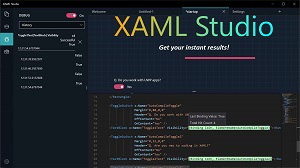News
Microsoft Garage's XAML Studio Does Real-Time UWP UI Changes
The Microsoft Garage initiative for experimental hacking projects championed by interns and staffers has come out with new projects including XAML Studio, used to smooth iterative development by quickly prototyping Universal Windows Project (UWP) apps.
XAML Studio lets coders see UI changes in their UWP apps immediately before being used in Visual Studio. Another new tool, called Team Retrospectives, is an Azure DevOps extension that boosts collaboration and productivity within the Azure Boards service.
 [Click on image for larger view.] XAML Studio (source: Microsoft).
[Click on image for larger view.] XAML Studio (source: Microsoft).
Microsoft Garage is described as "Microsoft’s official outlet for experimental projects from small teams across the company to test a hypothesis, receive early customer feedback, and determine product market fit." It has produced tools like Ink to Code, which is also designed to quicken the prototyping of UWP apps, along with Android UIs.
The latest UWP prototyping tool, XAML Studio, was created by Michael Hawker, a senior software engineer with the Partner, Analytics, and Essential Experiences (PAX) team, who is also a contributor to the Windows Community Toolkit.
“When you’re in Visual Studio, you have a variety of tools available to make coding and laying out your UI easy, but it’s not always straightforward to visualize the final result," Hawker was quoted as saying in a Jan. 16 blog post. "So, I thought to myself, 'What could I do to add to this experience?' XAML Studio is about that quick prototyping loop. Using this tool, I can type my XAML and see how it renders right away. Then, I can interact with it and explore how it behaves before it goes in my app.”
Features include:
- Rapidly Prototype UWP XAML UIs with Live Edit and Interaction
- Binding Debugger
- Data Context Editor
- Auto-save and restore Documents
- IntelliSense
- Documentation Toolbox
- Alignment Guides
- Namespace Helpers
"XAML Studio also includes a suite of tools to help you develop," the item's description reads on the Microsoft site. "Provide Data Context to your UI to fill it with static test data or live data from a JSON REST API. Then use our revolutionary binding debugging to not only see how a back-end data source connects to the front-end UI, but spot where errors are occurring and what the most recent values were."
Team Retrospectives, meanwhile, is described as "an extension for Azure DevOps that provides a first-class experience for retrospectives and general feedback board scenarios. Collect feedback on your project milestones, organize and prioritize, and create and track actionable tasks to help your team improve over time. Optimized for both desktop and mobile. Celebrate the good, improve the bad, and increase productivity with Team Retrospectives." The free tool has been installed 413 times, earning an average 3.8 (0-5 scale) rating from five developers who reviewed it.
About the Author
David Ramel is an editor and writer at Converge 360.